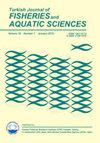Biogenic Synthesis of Iron Oxide Nanoparticle Using Padina Pavonica Extract: Application for Photocatalytic Degradation of Congo Red Dye, Neurotoxicity and Antioxidant Activity
IF 1.7
4区 农林科学
Q3 FISHERIES
引用次数: 2
Abstract
The current study focused on green synthesis of iron nanoparticles by Padina pavonica (Pa@FeNPs), removal activity of dye CR (Congo Red) and investigating antioxidant and neurotoxicity activities. The morphological and physical properties of Pa@FeNPs were characterized by FT-IR (Fourier Transform Infrared Spectroscopy), XRD (X-Ray Diffractometer), SEM (Scanning Electron Microscopy), EDX (X-Ray Spectroscopy), TEM (Transmission Electron Microscopy) and Zeta potential analyses. XRD and zeta potential analyses revealed a potential of-8.53 mV and formation of cubic crystals with an average dimension of 10.53-20.55 nm. The optimum conditions of pH, temperature, initial dye concentration and adsorbent amount for CR removal were found to be 4, 40°C, 20 ppm and 20 mg respectively. The CR removal percentage using Pa@FeNPs reached a very high efficiency of 95%. Langmuir Isotherm model (R2=0.99, 25°C) were best fitted to our data for evaluating dye adsorption behaviors of the Pa@FeNPs. Metal chelating activity in the aqueous extract of P. pavonica and Pa@FeNPs was found to be 74.71±2.16% and 64.95±0.42%, respectively. Inhibitory concentration 50 (IC50) values for P. pavonica aqueous extract and Pa@FeNPs were found to be 0.128 μg/mL and 400 μg/mL, respectively in the SH-SY5Y (Human neuroblastoma).巴豆提取物生物合成氧化铁纳米粒子:光催化降解刚果红染料、神经毒性和抗氧化活性的应用
帕沃妮卡绿色合成纳米铁的研究进展(Pa@FeNPs),对染料CR(刚果红)的去除活性,并研究其抗氧化和神经毒性活性。Pa@FeNPs通过FT-IR(傅立叶变换红外光谱)、XRD(X射线衍射仪)、SEM(扫描电子显微镜)、EDX(X射线光谱)、TEM(透射电子显微镜)和Zeta电位分析对其进行了表征。XRD和ζ电位分析显示电位为-8.53mV,并形成平均尺寸为10.53-20.55nm的立方晶体。pH、温度、初始染料浓度和吸附剂用量对CR去除的最佳条件分别为4、40°C、20ppm和20mg。使用Pa@FeNPs达到了95%的非常高的效率。Langmuir等温模型(R2=0.99,25°C)最适合我们的数据来评估Pa@FeNPs.帕vonica水提取物中的金属螯合活性Pa@FeNPs分别为74.71±2.16%和64.95±0.42%。帕沃尼察P.pavonica水提取物的抑制浓度50(IC50)值和Pa@FeNPs在SH-SY5Y(人神经母细胞瘤)中分别为0.128μg/mL和400μg/mL。
本文章由计算机程序翻译,如有差异,请以英文原文为准。
求助全文
约1分钟内获得全文
求助全文
来源期刊

Turkish Journal of Fisheries and Aquatic Sciences
FISHERIES-MARINE & FRESHWATER BIOLOGY
CiteScore
3.10
自引率
0.00%
发文量
43
审稿时长
3 months
期刊介绍:
Turkish Journal of Fisheries and Aquatic Sciences" (TrJFAS) is a refereed academic journal has been published by Central Fisheries Research Institute of Turkey and Japan International Cooperation Agency (JICA), and published in English.
It aims to address research and needs of all working and studying within the many varied areas of fisheries and aquatic sciences.
The Journal publishes English language original research papers, critical review articles, short communications and technical notes on applied or scientific research relevant to freshwater, brackish and marine environments.
TrJFAS was published biannually (April & November) between 2001 and 2009. A great number of manuscripts have been submitted to the journal for review from acceptance of the SCI index. Thereby, the journal has been published quarterly (March, June, September and December) from 2010 to 2017. The journal will be published monthly in 2018.
 求助内容:
求助内容: 应助结果提醒方式:
应助结果提醒方式:


